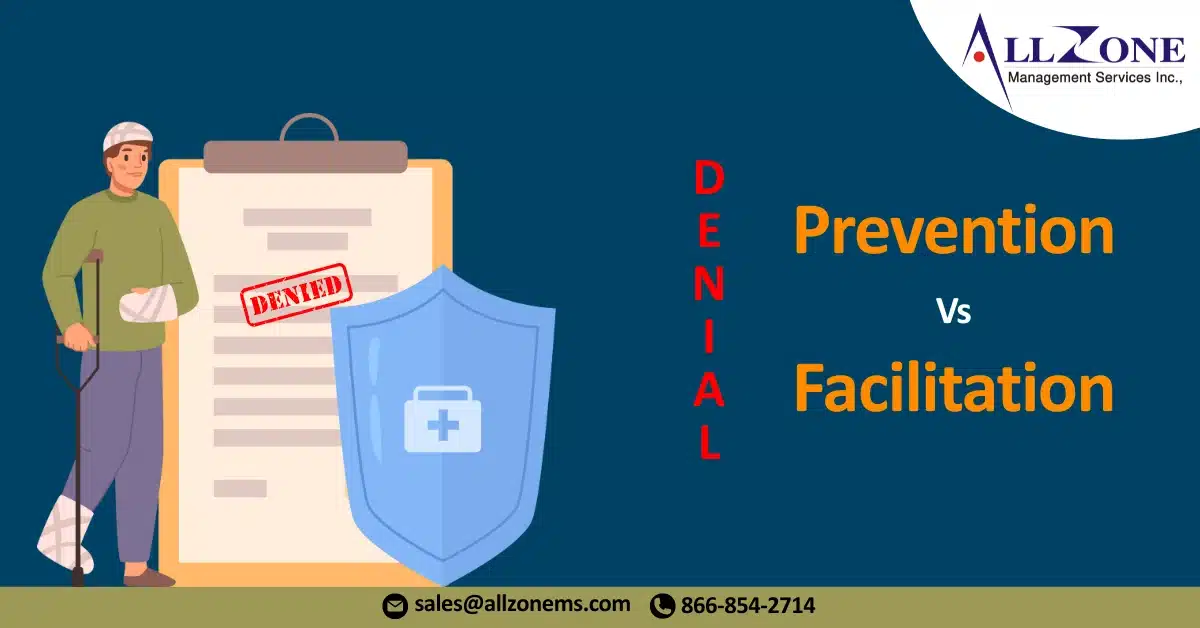In the healthcare revenue cycle, denials are inevitable — but how you manage them makes all the difference. A common discussion in this space centers around Denial Prevention vs. Denial Facilitation, two strategies that, while they may sound similar, have distinct purposes and outcomes. Understanding and effectively applying both can drastically improve your practice’s cash flow, reduce administrative burden, and enhance patient satisfaction.
In this blog post, we’ll explore the key differences between denial prevention and denial facilitation, when to apply each, and how to integrate both for a resilient revenue cycle management (RCM) strategy.
What is Denial Prevention?
Denial prevention refers to the proactive steps taken to stop claim denials from occurring in the first place. The focus is on identifying and fixing issues before claims are submitted to payers.
Common Denial Prevention Tactics:
- Eligibility Verification: Ensuring patients have active coverage and benefits before services are rendered.
- Pre-authorization Management: Securing necessary authorizations before treatment.
- Accurate Coding and Documentation: Leveraging trained medical coders to ensure the use of correct CPT®, HCPCS, and ICD-10 codes.
- Claim Scrubbing: Using billing software or clearinghouse tools to check claims for errors before submission.
- Training and Education: Regular training for front-desk and clinical staff on payer-specific rules and documentation best practices.
Why It Matters:
The American Medical Association estimates that the cost to rework a denied claim is approximately $25 per claim — and not all denials are recoverable. Preventing denials at the source reduces the need for rework, shortens payment cycles, and improves clean claim rates.
What is Denial Facilitation?
Denial facilitation, on the other hand, refers to the efficient and systematic process of managing denials after they occur. It ensures that denied claims are identified, corrected, appealed if necessary, and resubmitted promptly.
Key Denial Facilitation Strategies:
- Automated Denial Tracking: Leveraging RCM tools to flag and categorize denials in real time.
- Root Cause Analysis: Analyzing trends and identifying the underlying causes of recurring denials.
- Appeals and Re-submissions: Crafting timely and compelling appeal letters, with proper supporting documentation.
- Payer Communication: Establishing payer liaison roles or teams to handle direct interactions with insurers.
- Feedback Loop: Using denial data to improve upstream processes and staff training.
Why It Matters:
Even with the best denial prevention systems, some denials are unavoidable due to ever-changing payer rules, medical necessity disputes, or timing issues. A robust denial facilitation system ensures that practices don’t leave money on the table.
Denial Prevention vs. Denial Facilitation: Key Differences
| Feature | Denial Prevention | Denial Facilitation |
| Timing | Before claim submission | After claim denial |
| Goal | Avoid denials | Recover denied revenue |
| Approach | Proactive | Reactive |
| Focus | Data accuracy, policy adherence | Timely appeals, resolution |
| Tools | Claim scrubbing, pre-authorization, coding audits | Denial management software, appeal templates |
| Benefits | Higher first-pass rate, faster payments | Increased revenue recovery, reduced write-offs |
Why You Need Both for a Strong Revenue Cycle
Relying solely on one strategy is not enough. In the context of Denial Prevention vs. Denial Facilitation, it’s essential to understand that while denial prevention minimizes the volume of denials, no system is infallible. Denial facilitation ensures that unavoidable denials don’t become permanent revenue losses, providing a balanced approach to safeguarding revenue.
Integrated Approach Example:
A multispecialty clinic implemented real-time eligibility checks and improved coding accuracy, reducing their initial denial rate by 40%. Simultaneously, they used denial analytics software to track denial trends and automated workflows for follow-ups. The result? A 25% improvement in denial recovery rates and a 20-day reduction in average days in A/R.
How to Build an Effective Denial Management Ecosystem
1. Invest in Technology
- Use integrated practice management and EHR systems with robust claim scrubbing and denial tracking features.
- Implement RPA (Robotic Process Automation) to manage repetitive denial rework tasks.
2. Create Cross-Functional Teams
- Bring together coding, billing, front-desk, and clinical staff to identify issues holistically.
- Establish a regular cadence of denial review meetings.
3. Monitor and Measure KPIs
Key performance indicators (KPIs) to track:
- Denial rate (Target: <5%)
- First-pass resolution rate (Target: >90%)
- Appeal success rate
- Average days to resolution
- Top 5 denial reasons by payer
4. Educate and Empower Staff
Ongoing education on payer guidelines, documentation requirements, and new coding updates (like CPT® or ICD-10 changes) reduces the risk of both preventable and persistent denials.
5. Leverage Analytics
Advanced analytics can identify denial patterns by payer, specialty, provider, or service type. This helps in shifting from reactive firefighting to data-driven decision-making.
Common Denial Reasons & Where They Fall
| Denial Reason | Prevention | Facilitation |
| Invalid patient information | ✅ | ✅ |
| Missing pre-authorization | ✅ | ✅ |
| Incorrect coding | ✅ | ✅ |
| Non-covered services | ✅ | ✅ |
| Timely filing | ❌ (often too late) | ✅ |
| Medical necessity | ❌ (depends on payer) | ✅ |
This chart illustrates that many denial reasons fall under both categories, emphasizing the need for a hybrid approach.
Final Thoughts
Denial prevention and denial facilitation are not competing strategies — they are complementary pillars of a successful revenue cycle. While prevention improves claim accuracy and reduces denials upstream, facilitation ensures swift resolution of the denials that do occur.
Healthcare organizations that master both stand to gain the most — with faster reimbursements, lower administrative costs, and a more predictable cash flow.
Whether you’re a solo provider, a medical group, or a large healthcare system, building a culture that values both prevention and facilitation is essential for financial health and long-term sustainability.

